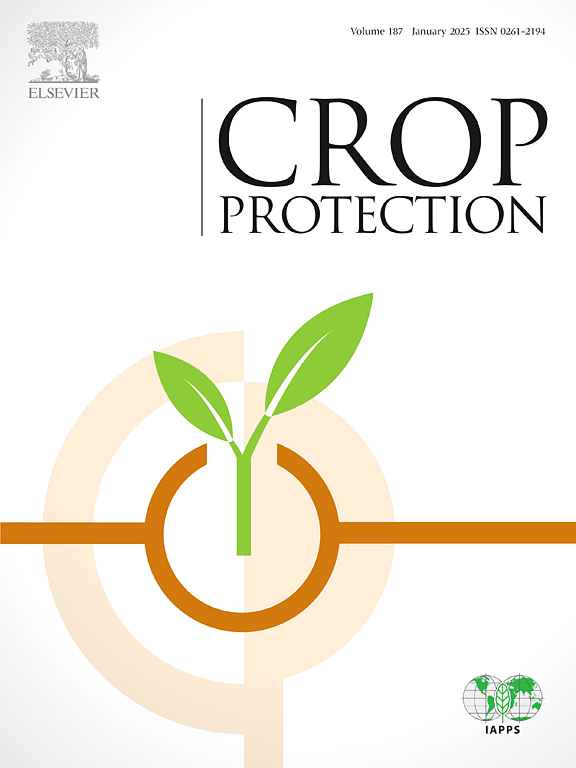Use of N-gene and Me-gene peppers as rootstocks to reduce the impact of the Southern Root-Knot Nematode, Meloidogyne incognita, on a highly susceptible bell pepper cultivar
IF 2.5
2区 农林科学
Q1 AGRONOMY
引用次数: 0
Abstract
Bell peppers are an excellent host for several root-knot nematode species, particularly the Southern Root-Knot Nematode (SRKN; Meloidogyne incognita) and can sustain serious damage because of these nematodes. One strategy to avoid nematode build-up and crop damage is the use of nematode resistant cultivars or plants grafted onto nematode resistant rootstocks. The objective of this study was to evaluate the effect of several M. incognita-resistant pepper cultivars and rootstocks on nematode multiplication, degree of pepper root-symptoms and yield. Nematode-susceptible pepper plants grafted onto resistant rootstocks were compared to susceptible non-grafted and own-root-grafted plants in greenhouse pot trials and field experiments. Plant growth or fruit yields were not different between the different rootstock treatments. Nematode-induced root symptoms (i.e., root-galling) and nematode reproduction, however, were strongly affected by the rootstock. Compared to plants growing on susceptible roots, root-galling and nematode reproduction were significantly reduced on the resistant rootstocks. There were no significant differences among the resistant rootstocks. Grafting susceptible bell pepper onto resistant rootstocks appears an effective strategy to manage root-knot nematodes. Increasing costs and regulation of nematicides used in soil fumigation, demand for organic produce, and developments in grafting technology resulting in lower transplant costs, likely will result in an increase in the use of grafted vegetables as an economically viable option in the future.
利用n基因和me基因辣椒作为砧木减少南方根结线虫对一个高易感甜椒品种的影响
甜椒是几种根结线虫的极好宿主,特别是南方根结线虫(SRKN; Meloidogyne incognita),并且可以承受这些线虫的严重损害。避免线虫积累和作物损害的一种策略是使用抗线虫品种或嫁接到抗线虫砧木上的植物。本研究的目的是评价几种抗黑穗病辣椒品种和砧木对线虫繁殖、辣椒根病程度和产量的影响。在温室盆栽试验和田间试验中,对抗病砧木嫁接的线虫敏感辣椒植株与未嫁接和自根嫁接的线虫敏感辣椒植株进行了比较。不同砧木处理间植株生长和果实产量无显著差异。然而,线虫诱导的根系症状(即根痛)和线虫繁殖受到砧木的强烈影响。在抗性砧木上,与在敏感根上生长的植株相比,根系腐蚀和线虫繁殖明显减少。抗性砧木间差异不显著。将易感甜椒嫁接到抗性砧木上是防治根结线虫的有效策略。土壤熏蒸中使用的杀线虫剂的成本和监管的增加,对有机农产品的需求,以及嫁接技术的发展导致移植成本降低,可能会导致嫁接蔬菜在未来作为一种经济可行的选择而使用的增加。
本文章由计算机程序翻译,如有差异,请以英文原文为准。
求助全文
约1分钟内获得全文
求助全文
来源期刊

Crop Protection
农林科学-农艺学
CiteScore
6.10
自引率
3.60%
发文量
200
审稿时长
29 days
期刊介绍:
The Editors of Crop Protection especially welcome papers describing an interdisciplinary approach showing how different control strategies can be integrated into practical pest management programs, covering high and low input agricultural systems worldwide. Crop Protection particularly emphasizes the practical aspects of control in the field and for protected crops, and includes work which may lead in the near future to more effective control. The journal does not duplicate the many existing excellent biological science journals, which deal mainly with the more fundamental aspects of plant pathology, applied zoology and weed science. Crop Protection covers all practical aspects of pest, disease and weed control, including the following topics:
-Abiotic damage-
Agronomic control methods-
Assessment of pest and disease damage-
Molecular methods for the detection and assessment of pests and diseases-
Biological control-
Biorational pesticides-
Control of animal pests of world crops-
Control of diseases of crop plants caused by microorganisms-
Control of weeds and integrated management-
Economic considerations-
Effects of plant growth regulators-
Environmental benefits of reduced pesticide use-
Environmental effects of pesticides-
Epidemiology of pests and diseases in relation to control-
GM Crops, and genetic engineering applications-
Importance and control of postharvest crop losses-
Integrated control-
Interrelationships and compatibility among different control strategies-
Invasive species as they relate to implications for crop protection-
Pesticide application methods-
Pest management-
Phytobiomes for pest and disease control-
Resistance management-
Sampling and monitoring schemes for diseases, nematodes, pests and weeds.
 求助内容:
求助内容: 应助结果提醒方式:
应助结果提醒方式:


